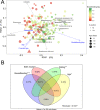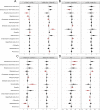Does entry to center-based childcare affect gut microbial colonization in young infants?
- PMID: 32581284
- PMCID: PMC7314774
- DOI: 10.1038/s41598-020-66404-z
Does entry to center-based childcare affect gut microbial colonization in young infants?
Abstract
Entry to center-based childcare (CC) at three months of life can be an important challenge for infants as it includes major stressors such as long maternal separations and frequently changing caregivers. Stress and the new environment may in turn alter the composition of the gut microbiota with possible implications for future health outcomes. As part of an ongoing longitudinal study, we investigated whether CC, as compared to being cared for by the parents at home, alters the composition of the gut microbiota, while accounting for known covariates of the infant gut microbiota. Stool samples of infants who entered CC (n = 49) and control infants (n = 49) were obtained before and four weeks after CC entrance. Using Redundancy analysis, Random Forests and Bayesian linear models we found that infant gut microbiota was not affected in a uniform way by entry to CC. In line with the literature, breastfeeding, birth mode, age, and the presence of siblings were shown to significantly impact the microbial composition.
Conflict of interest statement
The authors declare no competing interests.
Figures




Similar articles
-
Evolution of gut microbiota composition from birth to 24 weeks in the INFANTMET Cohort.Microbiome. 2017 Jan 17;5(1):4. doi: 10.1186/s40168-016-0213-y. Microbiome. 2017. PMID: 28095889 Free PMC article.
-
Successional Stages in Infant Gut Microbiota Maturation.mBio. 2021 Dec 21;12(6):e0185721. doi: 10.1128/mBio.01857-21. Epub 2021 Dec 14. mBio. 2021. PMID: 34903050 Free PMC article.
-
Timing of complementary feeding is associated with gut microbiota diversity and composition and short chain fatty acid concentrations over the first year of life.BMC Microbiol. 2020 Mar 11;20(1):56. doi: 10.1186/s12866-020-01723-9. BMC Microbiol. 2020. PMID: 32160858 Free PMC article.
-
Altered gut microbiota in infants is associated with respiratory syncytial virus disease severity.BMC Microbiol. 2020 Jun 1;20(1):140. doi: 10.1186/s12866-020-01816-5. BMC Microbiol. 2020. PMID: 32487019 Free PMC article.
-
Temporal bacterial and metabolic development of the preterm gut reveals specific signatures in health and disease.Microbiome. 2016 Dec 29;4(1):67. doi: 10.1186/s40168-016-0216-8. Microbiome. 2016. PMID: 28034304 Free PMC article.
Cited by
-
The Gut Microbiome in Early Life Stress: A Systematic Review.Nutrients. 2023 May 30;15(11):2566. doi: 10.3390/nu15112566. Nutrients. 2023. PMID: 37299527 Free PMC article.
-
Variation in the Conservation of Species-Specific Gene Sets for HMO Degradation and Its Effects on HMO Utilization in Bifidobacteria.Nutrients. 2024 Jun 15;16(12):1893. doi: 10.3390/nu16121893. Nutrients. 2024. PMID: 38931248 Free PMC article.
-
Seeding the Infant Gut in Early Life-Effects of Maternal and Infant Seeding with Probiotics on Strain Transfer, Microbiota, and Gastrointestinal Symptoms in Healthy Breastfed Infants.Nutrients. 2023 Sep 15;15(18):4000. doi: 10.3390/nu15184000. Nutrients. 2023. PMID: 37764787 Free PMC article.
-
Stress gets into the belly: Early life stress and the gut microbiome.Behav Brain Res. 2021 Sep 24;414:113474. doi: 10.1016/j.bbr.2021.113474. Epub 2021 Jul 16. Behav Brain Res. 2021. PMID: 34280457 Free PMC article. Review.
-
COVID-19 and the neonatal microbiome: will the pandemic cost infants their microbes?Gut Microbes. 2021 Jan-Dec;13(1):1-7. doi: 10.1080/19490976.2021.1912562. Gut Microbes. 2021. PMID: 33960272 Free PMC article.
References
Publication types
MeSH terms
LinkOut - more resources
Full Text Sources
Medical
Research Materials

